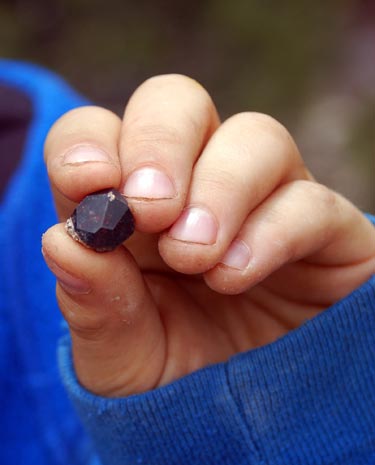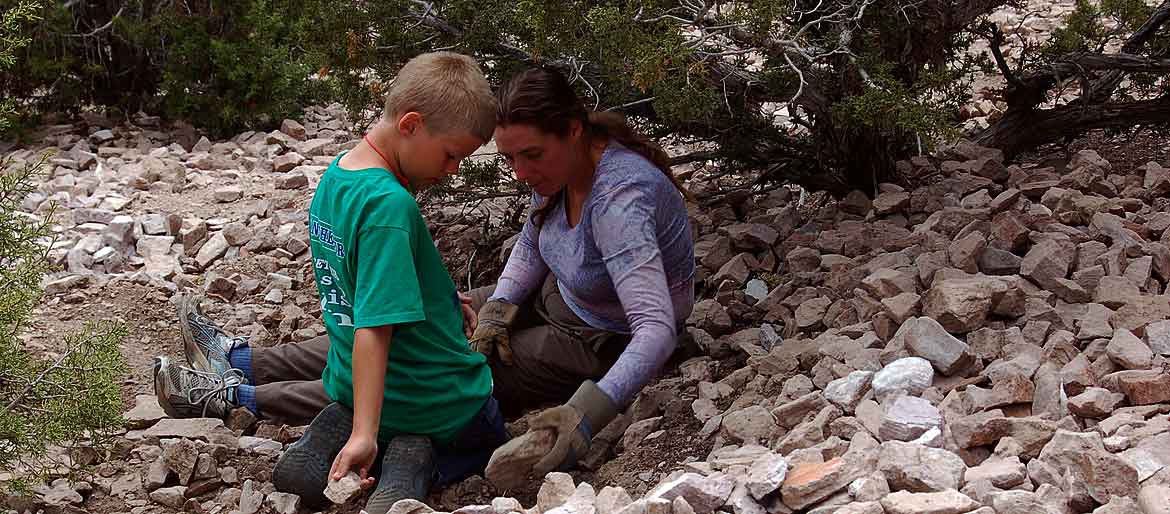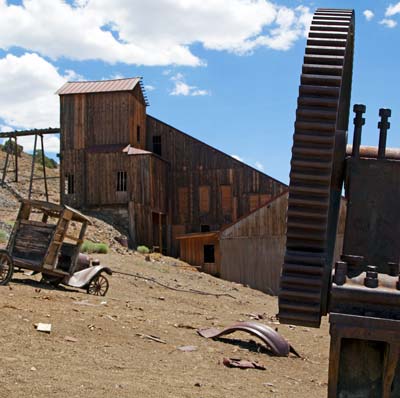
Download Road Log Garnets are crystallized minerals formed in igneous rocks. Larger garnet stones are precious gems due to their clear color and beauty. Garnet jewelry has been found in Egypt dating back to 3500 B.C.; it reached the height of fashion in the Victorian era. Many ancient myths are associated with garnets. In ancient times, images of lions were engraved upon garnet gems with the belief that this produced a magic amulet or charm providing the ultimate in protection. Throughout much of European history, superstitions persisted that garnets could prevent bad dreams and were able to cure diseases of the blood. Today, garnet remains a popular gemstone and is the birthstone for those born in the month of January. Garnets are also an important industrial mineral used as an abrasive in sand blasting and in manufacturing garnet sandpaper.
The volcano that produced the garnets in this area erupted the same time mammals were becoming dominant and modern plants were evolving, between 32 and 40 million years ago. In that era, Garnet Hill was actually several hundred feet below the volcano's surface. Rhyolite, which is a fine-grained igneous rock that is the volcanic form of granite, was being formed within the volcano. Rhyolite forms when magma erupts from the surface or invades rocks at a very shallow depth. As the molten rock cools, gases form pockets or vessicles in the rock allowing the garnet crystals to grow. The garnet crystals formed from the last bit of liquid cooling within the rock. The crystals vary in size, from small grains to crystals of one-quarter inch in diameter, and color of deep red to brownish red and orange. Rarely crystals of one half-inch size are found here. The garnets found at Garnet Hill are of the almandine group. Almandine is composed of iron, aluminum silicate and is deep red or brownish red in color.
The garnets were probably first noticed by early prospectors (1870's) searching for ore deposits in the area. A. C. Spencer of the U.S. Geological Survey wrote a report on the ore deposits in and around the Ely, Nevada area. It has since been mentioned in various mineralologist magazines and remains popular with mineral collectors.
On December 22, 1970, Garnet Hill and the surrounding area were withdrawn from mineral entry when the Garnet Fields Rockhound Area was created to ensure continued public recreational and scientific uses of the site.

Garnet Hill has drawn national attention for its beautifully rich, dark red garnets buried within the hillsides on the outskirts of Ely. These garnets are found in the rhyolitic volcanic rock that so densely populates the region.
Learn MoreThe garnets at this site may be found by two methods: by finding them on the surface or by digging and breaking rock.
To find them on the surface, look in low spots and gullies. As time passes, the garnets that are embedded in the rock are exposed to the elements and some eventually separate from the rock where they were formed. They end up being washed downhill and collect in depressions, somewhat like placer gold in a stream. As you search the ravines, keep your eyes open for dark red dots in the dirt and rubble, and you just might find a garnet or two.
If you prefer a more aggressive approach, you'll need a few tools to help you along. The basics are safety goggles, leather gloves, rock hammer, chisel, pry bar, pick, shovel, drinking water and something to hold the treasures you find. On summer days, a hat for protection from the sun is also a good idea.
First, pick a spot, dig a hole, gather the rocks you dig out and examine them. What you're looking for are rocks with holes in them. Carefully break them apart and see if you get lucky. Not all rocks will have garnets, but if you're persistent you are sure to be successful.
Lots of people just take home and display their garnets as they found them. You can also chisel them out of the rock and clean them up. Garnets are brittle, so be careful as you chisel away. Once the garnets are out of the rock, good old soap and water and scrubbing with an old toothbrush will get them all cleaned up. Don't forget, you can always get them polished and made into jewelry. Have fun!
You are in a high desert environment and are sharing that with the local wildlife. Rattlesnakes have occasionally been seen in this area. When you are wandering across Garnet Hill, use your shovel or hand tools to carefully turn over any rocks that may be sheltering a snake. These creatures prefer to leave you alone - unless you stick your hand in their face. A little bit of caution is always a good idea.
Garnet Hill is located in White Pine County, approximately 10 miles northwest of Ely, off of U.S. Highway 50. From Ely drive 6.4 miles west on US 50 to the sign indicating Garnet Hill. Turn east 1.7 miles to a signed road junction and travel south and west 1.4 miles to the parking area. Driving time from Ely to Garnet Hill is about 10 minutes.
There are four picnic sites with grills and a handicap accessible restroom available. A group barbeque area is also available. There are two informal areas for tents or small campers. RVs and large trailers are not recommended. No water is available.
Elevation: 7,400 ft
State: Nevada
District: White Pine County
Coordinates (WGS84): 39.28299, -114.94961
Nearest town: Ely, NV
Distance from the convention center: 8.3 miles

Garnet Hill is nationally known for its very dark colored garnets found in a flow banded rhyolitic volcanic rock. Two square miles of public land were designated as a public recreation area in 1970 to ensure continued public access to the site because of its recreational, rock hounding, and scientific study values. Image by Matt Bowers, Third Media.
The official event schedule for the 2025 NCKMS has now been updated. Please check our schedule page or download a PDF to your mobile device.

Since 1941 the NSS has been at the forefront of cave science, conservation, and exploration. Join our 8,500+ member community and come caving.

The ghost town of Berlin, Nevada, was established in 1897 as part of the Union Mining District after the opening of the Berlin Mine. At its peak, the town had about 75 buildings and 300 residents. It never prospered to the same extent as other boom towns like Tonopah and Goldfield, and declined following the Panic of 1907. The site was largely abandoned by 1911.
The site was acquired by the state of Nevada as part of Berlin-Ichthyosaur State Park in 1970.
![]() Partly cloudy, with a low around 20. North northwest wind 5 to 10 mph.
Partly cloudy, with a low around 20. North northwest wind 5 to 10 mph.
![]() Partly sunny. High near 47, with temperatures falling to around 40 in the afternoon. North northwest wind 5 to 10 mph.
Partly sunny. High near 47, with temperatures falling to around 40 in the afternoon. North northwest wind 5 to 10 mph.
![]() Mostly cloudy, with a low around 26. West wind 5 to 15 mph.
Mostly cloudy, with a low around 26. West wind 5 to 15 mph.

h2go Essen Vacuum Food Container
It's a double-wall, stainless steel, 17 oz capacity thermos from h2go®. This thing is more rugged than your cave pack! We've been trying to beat up the manufacturer's sample they sent, but it keeps winning. Hot things stayed hot, cold things stayed cold.
And ours will have the cool NCKMS logo printed on it.
